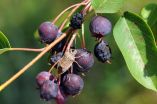(Press-News.org) NEW YORK (29 June 2015) -- There has been much recent discussion in the press of the plight of the so-called "sandwich generation," that is, adults who are responsible for the care of children as well as aging parents. The need for simultaneous childcare and eldercare is a reality that can limit families'--particularly women's--opportunities for paying work.
A new study by social scientists Emilio Zagheni and Denys Dukhovnov for the first time drills down into US statistics about who is providing this care, and who is receiving it. The study found that in 2012, adults in the United States provided more than a billion hours of unpaid caregiving every week--equal to the work of 30.5 million full-time caregivers. The researchers project a rise in the need for such care, reveal some surprises about who is providing care, and provide some reassurances about the future. The study appears in the June 2015 issue of Population and Development Review, a quarterly, peer-reviewed journal published by the Population Council.
Zagheni, an assistant professor of sociology at the University of Washington, and Dukhovnov, a graduate research associate at the CUNY Institute for Demographic Research in New York, used data from the American Time Use Survey (ATUS) to document unpaid caregiving by age and sex. The data were collected from about 36,000 people in the United States between 2011 and 2013. Unlike most other investigations of unpaid caregiving, the researchers examined data from the survey's time-use diaries as well as the survey's Eldercare Roster, providing much more detailed information than previously available about who is caring for whom.
For the purposes of this study, Zagheni and Dukhovnov defined "sandwich" caregivers as those who, during the course of a single day, provide unpaid care for at least one child and one adult, regardless of their relationship to the person receiving the care and regardless of living arrangements. A child receiving care may be a grandchild, an adult receiving care may be a spouse, and the people giving and receiving care may or may not live together.
The researchers found that about one-third of the US population provides unpaid care to another person. About 3 percent of the US population qualifies as sandwich caregivers by the researchers' definition, a smaller proportion than they anticipated.
Women provide more care than men, 137 minutes a day versus 110 minutes a day, respectively. Similarly, women who are sandwich caregivers provide 181 minutes of care a day, compared to 157 minutes a day for male sandwich caregivers.
The researchers noted other gender differences: grandmothers spend substantially more time with very young children, from birth to age 4, whereas grandfathers spend more of their caregiving time with children between the ages of 5 and 14.
Zagheni and Dukhovnov were surprised to discover that 20 percent of the caregiving time given to elderly persons (about 15 minutes per day) was given by other elderly people, perhaps spouses, rather than by adult children. "From the time-use perspective," write Zagheni and Dukhovnov, "people who provide simultaneous care to spouses and children or grandchildren are under greater pressure than those who have responsibilities toward their parents and their children or grandchildren."
In 2012, the value of unpaid care in the United States stood at $691 billion; the researchers project that with population aging, by 2050 (if people continue to produce the same amount of time for caregiving per capita), the value of unpaid care will rise to $839 billion. About 1.3 million additional providers will be needed in 2050 in order for beneficiaries to receive the same amount of care. However, write Zagheni and Dukhovnov, "considering that it would be spread over several decades, the size of the adjustment appears to be quite manageable for the United States."
Policy changes could make it easier for caregivers to stay in the work force and avoid career setbacks, suggest Zagheni and Dukhovnov. For example, "extra support to parents of young children in the form of community programs for children, tax breaks, and subsidies might allow parents to pay for childcare services that they would otherwise have to provide themselves."
INFORMATION:
This article is available free of charge at http://onlinelibrary.wiley.com/doi/10.1111/j.1728-4457.2015.00044.x/epdf.
Population and Development Review (PDR) seeks to advance knowledge of the relationships between population and social, economic, and environmental change and provides a forum for discussion of related issues of public policy. PDR is published quarterly on behalf of the Population Council by Wiley-Blackwell.
The Population Council conducts biomedical, social science, and public health research. We deliver solutions that lead to more effective policies, programs, and technologies that improve lives around the world.
Media contact
Office of Strategic Communications, Population Council: pubinfo@popcouncil.org; +1 212 339 0500
WASHINGTON (June 29, 2015) -- As Liberia rebuilds a health care system decimated by the 2014 Ebola outbreak, understanding precisely how far citizens live from health facilities and its impact on seeking care can help shape new strategies to improve health care delivery and reduce geographic disparities.
A new examination of remoteness as a barrier to health care, published online today in the Journal of Global Health, notes that most surveys and policy documents categorize families as living either in an urban or rural setting, and this dichotomy can mask disparities ...
When it comes to the art of persuasion, you can attract more followers if you turn conventional wisdom on its head and stress what you like, not what you do.
A new study, to be published in an upcoming issue of the Journal of Personality and Social Psychology, finds that people are more likely to conform to others' preferences than conform to others' actions. In other words, people want to like what others like, but they want to have or do what others don't have or don't do.
In the study, "Words Speak Louder: Conforming to Preferences More Than Actions," by University ...
DURHAM, N.C. - Researchers at Duke University School of Medicine and Brigham and Women's Hospital, Harvard Medical School have identified a mechanism that explains why some mutations can be disease-causing in one genome but benign in another.
In a study appearing June 29, 2015, in the journal Nature, the researchers compared thousands of human disease-causing mutations with the analogous sequences of some 100 animal species. They discovered non-human genomes carrying mutations that cause severe disease in humans, yet were benign in the animals.
Although generally in ...
The brown marmorated stink bug has a bad reputation. And for good reason: every summer, this pest attacks crops and invades homes, causing both sizable economic losses and a messy, smelly nuisance--especially in the eastern United States. A new study by entomologists at the University of Maryland shows that these pests, known simply as stink bugs, have a strong preference for ripe fruit. Moreover, stink bugs track their favorite fruits throughout the growing season in an effort to maximize their access to food.
The study, published online June 25, 2015 in the Journal ...
PHILADELPHIA -- Since their discovery in the 1950s, transfer RNAs (tRNAs) have been best known for their role in helping the cell make proteins from messenger RNA templates. However, recent studies have led to a previously-unsuspected concept that tRNAs are not always the end product; namely, they further serve as a source of small RNAs. Now researchers have discovered a new species of tRNA-derived small RNAs that are produced only in hormonally-driven breast and prostate cancers, and which contribute to cell proliferation. The results will be published online the week ...
The warm temperature on a summer's day is often a time for relaxing, but researchers from the University of Leicester have suggested that a 'thermosensory' gene could be responsible for changes in behaviour in different climates.
The researchers from the University of Leicester's Department of Genetics have explored how the biological clock can be affected by the environment by examining the fruitfly Drosophila melanogaster, which shows 24 hour biological cycles and is used as a model organism for studies into human rhythms.
Like many humans, the fly has a 'siesta' ...
It's been difficult to explain patterns of toxic mercury in some parts of the world, such as why there's so much of the toxin deposited into ecosystems from the air in the southeastern United States, even upwind of usual sources.
A new analysis led by researchers at the University of Colorado Boulder shows that one key to understanding mercury's strange behavior may be the unexpected reactivity of naturally occurring halogen compounds from the ocean.
"Atmospheric chemistry involving bromine and iodine is turning out to be much more vigorous than we expected," said ...
A University of Oklahoma professor studying malaria mosquito interaction has discovered a new mosquito protein for the development of a new vaccine that is expected to stop the spread of the disease in areas where it is considered endemic. Malaria is transmitted by mosquitoes, and it infects millions of people in Africa, Asia and South America every year, causing a global health crisis. In addition to the local populations, U.S. military personnel stationed in these areas and travelers to these malaria-prone areas are at risk of becoming infected.
Jun Li, assistant ...
UC Santa Barbara geologist Jim Boles has found evidence of helium leakage from the Earth's mantle along a 30-mile stretch of the Newport-Inglewood Fault Zone in the Los Angeles Basin. Using samples of casing gas from two dozen oil wells ranging from LA's Westside to Newport Beach in Orange County, Boles discovered that more than one-third of the sites -- some of the deepest ones -- show evidence of high levels of helium-3 (3He).
Considered primordial, 3He is a vestige of the Big Bang. Its only terrestrial source is the mantle. Leakage of 3He suggests that the Newport-Inglewood ...
WASHINGTON (June 29, 2015) -The American College of Cardiology, Heart Rhythm Society and Society for Cardiovascular Angiography and Interventions today released a new overview on the implantation of left atrial appendage occlusion devices.
The implantation of left atrial appendage occlusion devices may lower the risk of stroke in patients with atrial fibrillation. As new devices are developed, it is anticipated that the use of left atrial appendage occlusion technologies in clinical practice will expand. The authors of the paper urge that the new technology should be ...


